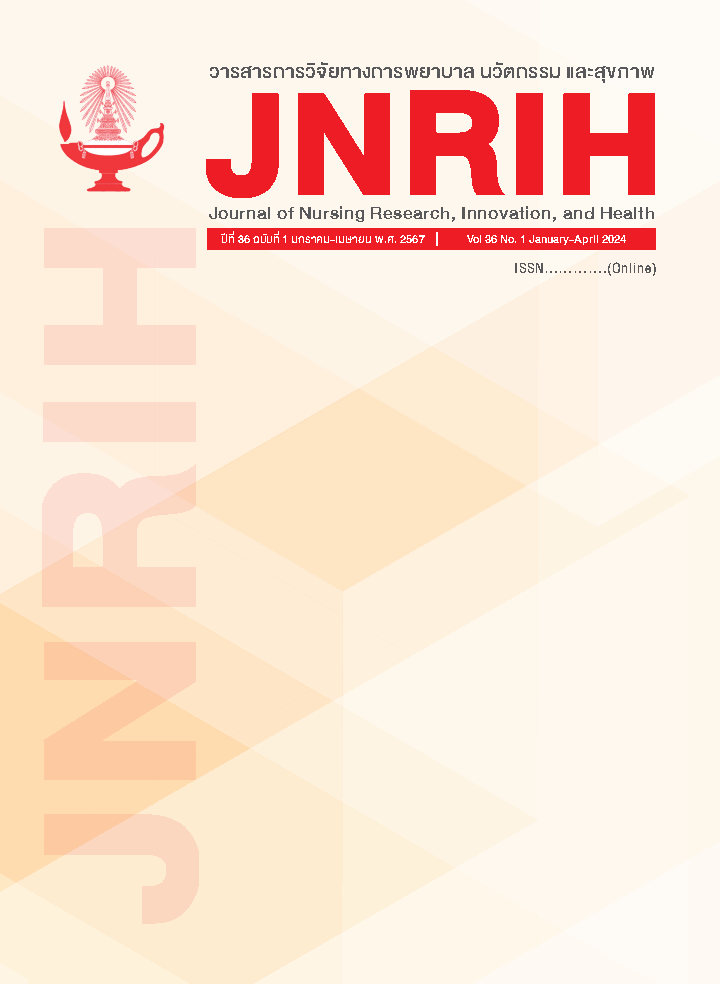ปัจจัยคัดสรรที่มีความสัมพันธ์กับภาวะไข้จากเม็ดเลือดขาวต่ำ ในผู้ป่วยมะเร็งต่อมน้ำเหลืองที่ได้รับยาเคมีบำบัด
คำสำคัญ:
ไข้จากเม็ดเลือดขาวต่ำ, มะเร็งต่อมน้ำเหลือง, ยาเคมีบำบัดบทคัดย่อ
วัตถุประสงค์: เพื่อศึกษาภาวะไข้จากเม็ดเลือดขาวต่ำ และความสัมพันธ์ของอายุ เพศ ระดับ Albuminในเลือด พฤติกรรมการดูแลตนเอง ชนิดของโรค ระยะของโรคมะเร็ง จำนวนครั้งที่ได้รับเคมีบำบัด โรคร่วม และกิจกรรมทางกาย กับภาวะไข้จากเม็ดเลือดขาวต่ำในผู้ป่วยมะเร็งต่อมน้ำเหลืองที่ได้รับยาเคมีบำบัด ของผู้ป่วยมะเร็งต่อมน้ำเหลืองที่ได้รับยาเคมีบำบัด
รูปแบบการวิจัย: การศึกษาครั้งนี้เป็นการวิจัยเชิงพรรณนา
วิธีดำเนินการวิจัย: กลุ่มตัวอย่าง คือ ผู้ป่วยมะเร็งต่อมน้ำเหลืองที่มาใช้บริการในแผนกผู้ป่วยนอกคลินิกโลหิตวิทยา โรงพยาบาลจุฬาลงกรณ์ จำนวน 114 คน เครื่องมือที่ใช้ในการวิจัย ประกอบด้วย แบบสอบถามพฤติกรรมการดูแลตนเอง และแบบสอบถามกิจกรรมทางกาย ตรวจสอบความตรงตามเนื้อหาได้ 1.0 เท่ากัน และตรวจสอบความเที่ยงได้ ค่าสัมประสิทธิ์แอลฟาของครอนบาคเท่ากับ 0.76 และ 0.72 ตามลำดับ วิเคราะห์ข้อมูลด้วยสถิติพรรณนา และวิเคราะห์การถดถอยโลจิสติค ผลการศึกษา: พบว่ามีผู้ป่วยมะเร็งต่อมน้ำเหลืองที่ได้รับยาเคมีบำบัดเกิดภาวะไข้จากเม็ดเลือดขาวต่ำร้อยละ 34.2 ส่วนใหญ่เกิดในครั้งแรกของการได้รับยาเคมีบำบัด ร้อยละ 48.7 และเกิดภาวะไข้จากเม็ดเลือดขาวต่ำเพียง 1 ครั้ง คิดเป็นร้อยละ 84.6 โดยปัจจัยที่มีความสัมพันธ์ทำให้ผู้ป่วยมะเร็งต่อมน้ำเหลืองเกิดภาวะไข้จากเม็ดเลือดขาวต่ำมากขึ้น ได้แก่ เพศหญิง ผู้ที่มีอายุ 60 ปีขึ้นไป ระดับอัลบูมินในเลือดต่ำ(<3.5 g/dL) เป็นมะเร็งต่อมน้ำเหลืองระยะแพร่กระจาย จำนวนครั้งที่ได้รับยาเคมีบำบัด และการมีโรคร่วม (OR=5.43, 1.68, 4.76, 1.62, 1.83, 2.33 ตามลำดับ p<.05) และปัจจัยที่มีความสัมพันธ์ทำให้เกิดภาวะไข้จากเม็ดเลือดขาวต่ำลดลง คือ กิจกรรมทางกาย(OR= 0.58, p<.05) ส่วนปัจจัยที่ไม่มีความสัมพันธ์กับภาวะไข้จากเม็ดเลือดขาวต่ำ ได้แก่ พฤติกรรมการดูแลตนเอง และชนิดของโรคมะเร็ง(OR=0.62, 1.15 ตามลำดับ p >.05)
เอกสารอ้างอิง
Krell D, Jones AL. Impact of effective prevention and management of febrile neutropenia. Br J Cancer. 2009;101 Suppl 1:S23-6. doi: 10.1038/sj.bjc. 6605273. Cited in: PubMed; PMID: 19756004; PMCID: PMC2752228.
De Naurois J, Novitzky-Basso I, Gill M, Marti FM, Cullen M, Roila F. Management of febrile neutropenia: ESMO clinical practice guidelines. Ann Oncol. 2010;21: V252-6.
Freifeld AG, Bow EJ, Sepkowitz KA, Boeckh MJ, Ito JI, Mullen CA, et al. Clinical practice guideline for the use of antimicrobial agents in neutropenic patients with cancer: 2010 update by the infectious Diseases society of America. Clin Infect Dis. 2011;52(4):E56-93. doi: 10.1093/cid/cir073. Cited in: PubMed; PMID: 21258094.
Siriso J, Thanasilp S, and Pudtong N. Selected Factors Related to the Quality of Death of Persons with Terminal Cancer as Perceived by Family Caregivers. J Nursing Science Chulalongkorn University. 2017;29(2):112-123.
Puchisathian J, Rojnuckarin P. High incidence of febrile neutropenia in Non-Hodgkin Lymphoma patients receiving CHOP chemotherapy despite G-CSF prophylaxis. J Hematol Transfus Med. 2017;27(1): 45-55.
Crawford J, Becker PS, Armitage JO, Blayney DW, Chavez J, Curtin P, et al. Myeloid growth factors, version 2.2017, NCCN clinical practice guidelines in Oncology. J Natl Compr Canc Netw. 2017;15 (12):1520-41. Epub 2013 Jul 2. doi: 10. 1177/1078155213492450. Cited in: PubMed; PMID: 23824496.
Lyman GH, Abella E, Pettengell R. Risk factors for febrile neutropenia among patients with cancer receiving chemotherapy: A systematic review. Crit Rev Oncol Hematol. 2014;90(3):190-9. Epub 2013 Jul 2. doi: 10.1177/1078155213492450. Cited in: PubMed; PMID: 23824496.
Choi YW, Jeong SH, Ahn MS, Lee HW, Kang SY, Choi J-H, et al. Patterns of neutropenia and risk factors for febrile neutropenia of fiffuse large B-Cell Lymphoma patients treated with Rituximab-CHOP. J Korean Med Sci. 2014;29(11):1493-500.
Kim YR, Kim SJ, Park Y, Oh SY, Yun HJ, Mun YC, et al. Risk factors for neutropenic fever in non-Hodgkin’s lymphoma patients with primary granulocyte colony-stimulating factor prophylaxis. Korean J Intern Med. 2021;36(5):1181-9. Epub 2021 Jul 16. doi: 10.3904/kjim. 2020.206. Cited in: PubMed; PMID: 34265889; PMCID: PMC8435507.
Connors JM, Jurczak W, Straus DJ, Ansell SM, Kim WS, Gallamini A, et al. Brentuximab vedotin with chemotherapy for stage III or IV Hodgkin’s Lymphoma. N Engl J Med. 2018;378(4):331-44.
Moreau M, Klastersky J, Schwarzbold A, Muanza F, Georgala A, Aoun M, et al. A general chemotherapy myelotoxicity score to predict febrile neutropenia in hematological malignancies. Annals of Oncology. 2009;20(3):513-9. Epub 2009 Jan 12. doi: 10.1093/annonc/mdn655. Cited in: PubMed; PMID: 19139177.
Lekdamrongkul P. Factors associated with febrile neutropenia in acute leukemic patients receiving chemotherapy. [Thesis]. Mahidol University; 2009. (In Thai)
Yokoyama M, Kusano Y, Nishihara A, Inoue N, Nishimura N, Mishima Y, et al. Incidence and risk factors for febrile neutropenia in Japanese patients with non-Hodgkin B cell lymphoma receiving R-CHOP: 2-year experience in a single center (STOP FN in NHL 2). Support Care Cancer. 2020;28(2):571-9. Epub 2010 Nov 20. doi: 10.1016/j.ejca.2010.10.013. Cited in: PubMed; PMID: 21095116.
Salar A, Haioun C, Rossi FG, Duehrsen U, Pettengell R, Johnsen HE, et al. The need for improved neutropenia risk assessment in DLBCL patients receiving R-CHOP-21: Findings from clinical practice. Leuk Res. 2012;36(5):548-53. Epub 2012 Mar 3. doi: 10.1016/j.leukres. 2012.02.002. Cited in: PubMed; PMID: 22385870.
Thai Health Promotion Foundation (Thai Health Promotion Foundation), Department of Health, Misistry of Publish Health. Physical activity promotion plan (B.E 2561-2573) [Internet]; 2017 [cited 2018 Dec 20]. Available from: http://resource.thaihealth.or.th/library/hot/17077
Sirichantharawat C, Pathnapalagons R. Risk factors of febrile neutropenia in patients with Lymphoma receiving chemotherapy. Health science clinical research. 2021; 36(1):74-83.
Sütcüoğlu O, Akdoğan O, Gürler F, Kurt İnci B, Özdemir N, Özet A, Yazıcı O. The role of serum albumin/globulin ratio in combination with prognostic risk indexes of febrile neutropenia. Int J Clin Pract. 2021 Jul;75(7):e14185. Epub 2021 Apr 5. doi: 10.1111/ijcp.14185. Cited in: PubMed; PMID: 33783936.
Lavie CJ, Lee DC, Sui X, Arena R, O’Keefe JH, Church TS, Milani RV, Blair SN. Effects of running on chronic diseases and cardiovascular and all-cause mortality. Mayo Clin Proc. 2015 Nov;90(11):1541-52. Epub 2015 Sep 8. doi: 10.1016/j.mayocp. 2015.08.001. Cited in: PubMed; PMID: 26362561.
ดาวน์โหลด
เผยแพร่แล้ว
ฉบับ
ประเภทบทความ
สัญญาอนุญาต
ลิขสิทธิ์ (c) 2024 วารสารพยาบาลศาสตร์ จุฬาลงกรณ์มหาวิทยาลัย

อนุญาตภายใต้เงื่อนไข Creative Commons Attribution-NonCommercial-NoDerivatives 4.0 International License.
ลิขสิทธิ์ของบทความที่ตีพิมพ์เป็นของวารสารพยาบาลศาสตร์ จุฬาลงกรณ์มหาวิทยาลัย ทั้งฉบับตีพิมพ์เป็นรูปเล่มและเอกสารออนไลน์



